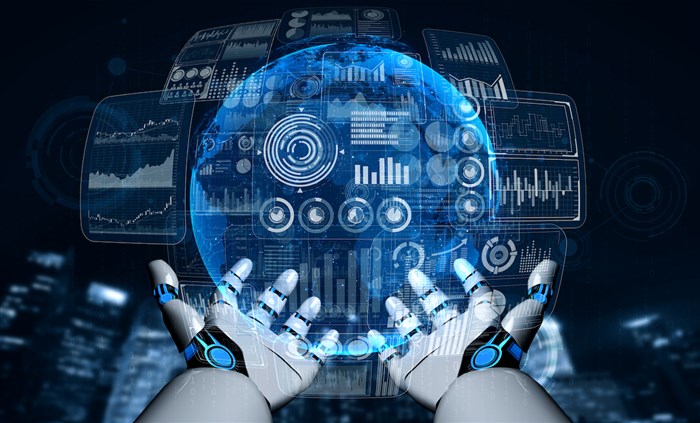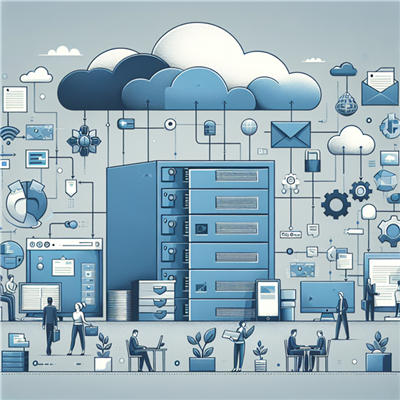
Technology is a part of our everyday lives. It is impossible to imagine even an hour without using a tech product. We are surrounded by technology, from phones to smart lights at home. Most of us are familiar with the term Artificial Intelligence. Many of us have used Machine Learning, Artificial Intelligence, and Deep Learning interchangeably because of the enduring misconceptions surrounding these terms.
However, these are three unique technologies. Are they interconnected? Yes. Are they similar? No. To explain the difference in one line - Machine Learning is a subset of Artificial Intelligence, and Deep Learning is a subset of ML (Machine Learning). In this blog, we have discussed all three technologies individually with their working, applications, and key differences to give you a better understanding. Read on to learn more.
What Is Artificial Intelligence (AI)?
When you think of artificial intelligence, the first thing that may pop into your mind may be evil intelligent robots ready to take over the earth. Movies and television show devilishly depict AI robots laying siege to our planet and destroying humanity.
Artificial intelligence is completely different from this. It is a way that makes computers and software think like humans. One of the most common examples of artificial intelligence is the AI assistants like Siri and Alexa.
AI mimics human intelligence by analyzing our cognitive processes and brain activity to create machines that can think and act like humans. John Mccarthy coined the term artificial intelligence in 1956. You can trace its roots back to Alan Turing. In 1950, Turing published a landmark paper discussing the possibility of machines that think and developed the famous Turing test.
Types of AI
Now that you understand AI, it is equally important to learn about its different types. AI experts have divided it based on four factors:
Reactive
This AI machine works based on present data while considering the present situation. It only performs predefined tasks, does not have memories, and does not make any new decisions. The machine is built only to react. One of the most famous examples of reactive AI is the IBM chess program Deep Blue.
Limited Memory
These AI machines have limited memory to store events and collect data. They use this data to make decisions and evaluate future actions. Self-driving cars are an example of limited memory AI.
Theory of Mind
This type of AI understands human emotions and thoughts. The focus is on emotional intelligence.
Self-Aware
Self-aware AI machines are still under development. They are being built to be aware of the emotional state and, once developed, will reach the same consciousness a human possesses.
Based on capability, experts have divided AI into three parts:
Artificial Narrow Intelligence (ANI)
ANI is also called Weak AI. It includes machines that can only perform predefined tasks. These machines do not have any thinking ability. Common examples of this AI include Siri, Apple’s virtual assistant, and industrial robots.
Artificial General Intelligence (AGI)
Also known as Strong AI, these types of AI can replicate the cognitive abilities of a human brain. They can work independently and find solutions just like a human can. They will possess the ability to function and perceive like humans.
Artificial Super Intelligence (ASI)
ASI will be far more advanced than any form of intelligence if developed. They will have human intelligence and advanced processing, decision-making, and analysis capabilities. AI will surpass human capabilities, but at this stage, AI only exists in theory:
Applications of AI
AI is all pervasive. Here are some of its applications:
● Automation: Robotic process automation is one example of AI. This type of software automates menial tasks and saves time and resources.
● Banking Fraud Detection: AI is also used in fraud detection software to predict whether a transaction can be fraudulent.
● Virtual Assistants: Virtual assistants, such as Siri, Alexa, and Cortana, are all examples of AI. They respond to user queries, collect information, and personalize solutions.
● AI Robots: Sophia is one example of an AI robot.
● Security: AI is also extensively used in cybersecurity solutions to identify and predict threats.
Pros and Cons of AI
While AI has greatly simplified our lives, it does have its fair share of pros and cons. Here are some of them:
Pros
● Reduces human error
● Excellent at performing detail-oriented tasks
● Available 24*7
● Enables quick and unbiased decision making
● Performs repetitive tasks
Cons
● It is expensive
● Cannot replace humans
● Lacks creativity
● Increases unemployment
● Lacks ethics and morality
● Does not promote improvement without human intervention
Related: What is Artificial Intelligence? How Does AI Work? (AI Types, History, and Future)
What is Machine Learning (ML)?
A subset of Artificial Intelligence, Machine Learning is the technology that allows computers and software to learn and predict more accurately. This software is not directly programmed to do so. The more data the machine gets, the more it will modify and adapt. While it works with structured and unstructured data, it prefers structured data more.
How Does ML Work?
The basic working of ML is as follows. It uses historical data to learn and develop prediction models. It predicts outcomes by using these learnings each time new data is received. Many businesses today use machine learning to view new trends in customer behavior and their operations.
Types of ML
There are primarily three types of ML algorithms.
Supervised Learning
The machine receives the sample labeled data to predict the output in this type. The system uses this data to create a model and learn. After training, data scientists use more sample data to check the model.
Support vector machines, decision trees, linear regression, and spam detection are the most common models used in SL. Classification and regression are the two types of supervised learning.
Unsupervised Learning
The system learns without any supervision in this type of training. The sample data given to the system for training is not labeled, classified, or categorized. The system works on the data without any guidelines and predetermined results. The machine analyzes the data to find trends and patterns.
Some of its applications include product segmentation, labelling unlabeled datasets, and similarity detection. The two types of unsupervised learning are association and clustering.
Reinforcement Learning
This type of learning trains an agent to work in an uncertain environment. It is a feedback-based method where the agent is rewarded for the right actions and penalized for the wrong ones. The agent uses this to learn and improve. Another feature of this learning is that the agent interacts with its environment.
Applications of ML
Systems and applications. Here are some of them:
● Social media applications like Facebook use ML to personalize your feeds and give you page suggestions and recommendations.
● E-commerce websites frequently use ML to provide product recommendations.
● ML is also used in image recognition.
● It is also commonly used in language translation.
Pros and Cons of ML
Pros
● ML can identify trends and patterns easily.
● It improves with time.
● It has a wide range of applications.
● It can handle multidimensional data.
Cons
● It is more susceptible to errors.
● It requires lots of time and resources.
Related: Machine Learning and its Importance
What is Deep Learning?
Deep Learning is a subset of Machine Learning. It uses an artificial neural network, similar to a biological neural network, to identify patterns and provide the desired output. Unlike machine learning, deep learning does not require manual inputs. It uses large amounts of data and automatically identifies patterns to classify it. Deep learning algorithms can work with structured and unstructured data.
Artificial Neural Network
Artificial Neural Network (ANN) has three layers. These layers are interconnected:
● Input layer: This layer takes the input data from various external sources and gives it to the hidden layer.
● Hidden layer: As the name indicates, this layer has many hidden layers where experts perform computation, computing the final output for the output layer to display the same.
● Output layer: This layer shows the computed output.
Types of Deep Neural Networks
There are many types of deep neural networks. Some of them include the following:
Convolutional Neural Networks (CNN)
CNNs help with image processing and object detection. They have multiple layers that process the data.
Recurrent Neural Networks (RNN)
RNNs help with natural language processing, machine translation, and image captioning. It uses sequential data for prediction.
Generative Adversarial Networks (GAN)
GANs have two components: a generator and a discriminator. Both of these components create new data instances similar to training data. It helps in developing realistic images that may look authentic to humans.
Feed-forward Neural Networks
Feed-forward neural networks are the most basic form of ANN, where data only travels in the forward direction, from input to output. Most vision recognition applications use this network to work.
Applications of Deep Learning
Common applications of deep learning are as follows:
● Virtual assistants use deep learning to improve user experience with each command.
● Chatbots also use deep learning to create different reactions.
● You can use deep learning techniques to generate automatic subtitles.
● WaveNet, a deep learning-based generative model, is used to create raw audio.
● Another application is image colorization.
Pros and Cons of Deep Learning
Pros
● Labeled data are not required.
● It can produce high-quality outputs.
● Deep learning models are cost-effective.
● It is scalable.
Cons
● It requires a massive amount of data
● It also needs huge processing power
Differences between Artificial Intelligence, Machine Learning, Deep Learning
Now that the details of AI, ML, and Deep Learning are clear, it is important to understand their differences. All of these techniques are connected. Artificial intelligence is a broad field containing both machine learning and deep learning. Machine learning is highly effective in identifying patterns in large and small datasets. Deep learning is a step ahead in AI technology and uses neural networks to analyze data.
Here are the major differences between AI, ML, and DL.
Basis
Artificial Intelligence
Machine Learning
Deep Learning
Meaning
AI enables machines to think and act like humans.
ML helps improve the performance of a machine or computer by learning from past performance.
Deep learning algorithms identify patterns and classify information from the input to provide the output. It uses the artificial neural network to achieve its goals.
Goal
One of the primary goals of AI is to develop computer systems that can solve complex problems independently.
One of the goals of ML is to develop a machine that can learn using past performance/data.
Deep learning improves with each new information and performs complex tasks without human intervention.
Subsets
AI is an independent technology.
ML is a subset of AI.
Deep learning is a subset of ML.
Scope
AI has a much wider scope than both ML and deep learning.
ML has a limited scope as compared to AI.
Deep learning is a rather new technology with a wide scope.
Examples
AI is pervasive. Examples include AI assistants, such as Alexa and Siri, and the Humanoid robot Sophia.
Some of the most common applications of ML include language translation, image recognition, medical diagnosis, and speech recognition software.
Autonomous vehicles and facial recognition are two popular examples of deep learning.
Types
Experts classify AI into four types based on functionality: reactive machines, limited theory, theory of mind, and self-awareness. They classify AI into three types based on capabilities: narrow AI, general AI, and super AI.
ML scientists divide ML into four types: supervised, unsupervised, and reinforcement learning.
Deep learning primarily has four types: CNN, RNN, GAN, and DBN.
Human Intervention
AI can work independently. It develops and grows with human interaction.
ML requires human intervention when the output is not the same as desired.
Deep learning algorithms learn from their past and mistakes, requiring less human intervention.
This blog has explored AI, ML, and deep learning in detail and should help clarify these techniques.


.jpgM.jpg)




COMMENT